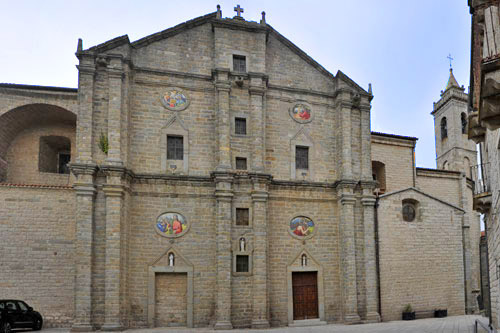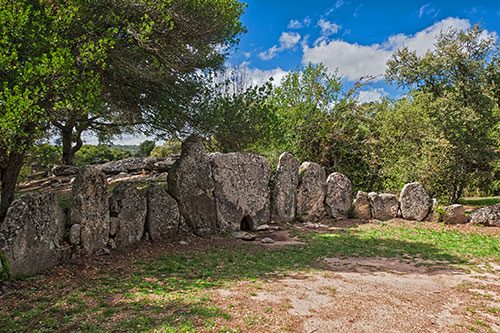Tempio Pausania and Surroundings
map of Tempio and Surroundings with the marked sights
Tempio Pausania
 Tempio Pausania, the largest town in the inland area of Gallura, offers a charming atmosphere.
Tempio Pausania, the largest town in the inland area of Gallura, offers a charming atmosphere.
The historic cobblestone streets and houses in the center are made from the light granite of the surrounding area. The most beautiful facades can be found along Via Roma and at Piazza Gallura.
The town is also famous for its mineral springs, with some of the water bottled and offered throughout Sardinia.

At Piazza San Pietro, there are three churches: Chiesa Santa Croce, Oratorio del Rosario, and the Cattedrale San Pietro (photo).
The cathedral is the largest church in Tempio Pausania and also the one with the most magnificent furnishings. The building dates back to the 15th century. Later, colorful mosaics were added to the facade.
The entrance is somewhat hidden on the west side.

At the edge of town, near the post office, begins Viale Fonte Nuova.
A beautiful shaded avenue leads to the Fonte Nuova spring. (see map)
Below the spring, the water flows through several artificially created basins and cascades.
Here you can rest in the shade and enjoy the view towards Aggius. In the evening, the avenue is a popular promenade for the residents of Tempio.
Fonte Rinaggiu
 The spring is located in a beautiful, shaded park on the southwestern outskirts of Tempio. (see map)
The spring is located in a beautiful, shaded park on the southwestern outskirts of Tempio. (see map)
The locals love to use the park as a picnic spot, and it gets quite crowded, especially on weekends.
The water from the spring is considered diuretic and beneficial for kidney ailments. Its healing properties were already known in ancient times and are famous throughout Sardinia.
According to analyses, it is classified as “cold, naturally oligomineral water from granite rock.”
Stazione ferroviaria
 The small train station of Tempio is also worth seeing.
The small train station of Tempio is also worth seeing.
The ticket hall is decorated with oil paintings depicting scenes from old Sardinian village life.
The paintings were done by Giuseppe Biasi, who was commissioned for this work in the 1930s. Biasi was one of the most famous Sardinian artists of the 20th century.
Monte Limbara

Monte Limbara is the local mountain of Tempio Pausania, standing at 1360 meters, making it the highest peak in northern Sardinia.
The mountain slopes are covered with dense forests that reach almost to the summit. Beautiful hiking trails lead up.
Part of the summit is occupied by transmission towers. For their construction and maintenance, an asphalt road was built, allowing you to drive almost to the top.
On a clear day, the view stretches across the entire Gallura and sometimes even to Corsica.
Nuraghe Majori
 Nuraghe Majori is located north of Tempio, a bit off the SS 133. (see map)
Nuraghe Majori is located north of Tempio, a bit off the SS 133. (see map)
You can climb a stone staircase to the upper platform. From here, you have a beautiful view of the town and the surrounding forests.
It is the only Nuraghe in the area that is accessible to visitors.
Cork Oak Forests
 They are the hallmark of the inner Gallura.
They are the hallmark of the inner Gallura.
Everywhere around Tempio Pausania, roads lead through sparse forests consisting almost exclusively of cork oaks.
The freshly stripped trunks glow rust-red until new bark has formed.
A tree is first stripped when it is about 25 years old. It then takes 8-10 years for enough cork to grow back for the next harvest. The quality improves with each stripping, and the cork becomes finer, but after a maximum of 9 harvests, the tree is exhausted.
In addition to harvesting cork bark, the forests are also used for grazing cattle, sheep, and pigs.
Calangianus
 The village in the heart of Gallura is the center of the Sardinian cork industry. It also houses Italy’s only specialized school for cork processing.
The village in the heart of Gallura is the center of the Sardinian cork industry. It also houses Italy’s only specialized school for cork processing.
Cork has great economic importance for the island. Sardinia accounts for 80% of Italy’s total cork production.
Everywhere you see pieces of bark stacked for drying, awaiting further processing. After the initial drying, the bark is boiled, then pressed, and dried again.
The best quality is used for wine and champagne corks. Shoe soles, insulating material, and flooring are also made from cork.
Souvenir manufacturers have also discovered this natural material, and you can buy cork boxes, cork picture frames, cork postcards, and the like all over Sardinia.
Museo del Sughero (Museum of Cork)
 In Calangianus, an interesting museum was established a few years ago in a former Franciscan monastery.
In Calangianus, an interesting museum was established a few years ago in a former Franciscan monastery.
It is dedicated to the cultivation, harvesting, and processing of cork.
On the ground floor, various historical machines and tools used in the post-harvest processing of cork are on display.
The focus is primarily on the production of bottle corks.
At the entrance, there is also a small souvenir shop where you can purchase a variety of items made from cork.
 On the first floor, screens display the cork harvest process, including the peeling of bark from cork oaks.
On the first floor, screens display the cork harvest process, including the peeling of bark from cork oaks.
There is also an exhibition showcasing the wide range of products now made from this versatile material.
Guided tours are offered in various languages.
If you wish to join one, it’s best to inquire in advance by phone to find out the schedule.
Phone: +39 346 369 3859
How to get there: The museum is located in the center of Calangianus at Via S. Francesco, 3 (see map). Parking is available nearby.
Tomba dei Giganti di Pascaredda
 The Giants’ Tomb dates back to the Late Bronze Age (1700–1400 BC). It was excavated and restored in 1998.
The Giants’ Tomb dates back to the Late Bronze Age (1700–1400 BC). It was excavated and restored in 1998.
The front section (known as the exedra) consists of upright granite slabs and is approximately 18 meters wide. At the center stands a portal slab over 2 meters tall, which is unusually wide compared to other tombs.
The burial chamber behind it, 12 meters long, is still largely covered by an earthen mound.
How to get there: The parking lot is accessible from the SS127, directly opposite the turnoff to Nunchis. (see map)
From the parking lot, it takes about 15 minutes on foot to reach the tomb, and the path is well marked.
